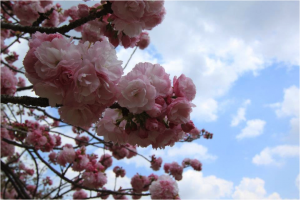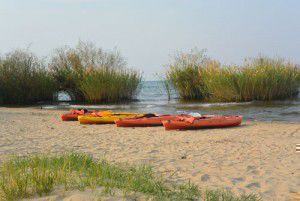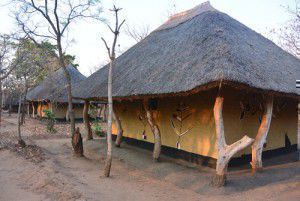10 reasons to visit… Tokyo
To finish up our Japanese week, Safia’s written today’s blog post on her top ten reasons to visit Tokyo.
Do you live in Tokyo, or have you visited? Please share your own top tips in the comments!
1. The old and the new
Before I even start talking about specific points of interest, all you need to do is to walk down the street to see how traditional and modern Japanese culture both collide and sit beautifully side by side. Temples of all shapes and sizes pop up everywhere in between buildings and houses (many of which are open to the public), kimonos and yukatas are still worn as everyday wear and not just for special occasions, and I will never stop being excited about literally being able to buy anything under the sun from a vending machine.
2. Harajuku/Meiji Temple
For the weird, the wonderful and the fandom, Harajuku is the place to be to find the centre of Japanese youth and fashion culture. If you like to people-watch, there are usually a handful of cosplayers or colourfully dressed youths hanging around the station area and the backstreets are packed with little independent boutiques. In stark contrast, Meiji Jingu is also located here with the entrance round the corner from the station, and is an Imperial Shrine dedicated to Emperor Meiji and his wife Empress Shoken. If you’re lucky enough you may even get to see a wedding, as it is a popular venue for forthcoming nuptials.
3. Tsukiji Market
There are very few places in the world where I would consider waking up at 5am just to get some fish, but Tsukiji Market is definitely one of them. If the idea of raw fish (sashimi) sends you heaving, I urge you to give it another go for the love of tuna that just melts on your tongue. I promise when it’s this fresh and prepared this delicately there is nothing else like it, and there will be plenty of other sushi options as well. Personally as a foodie, I skipped straight to the food, but if you want to see the tuna auction you really have to get there early as there are limited spaces for viewers. Some of the queues for the restaurants can get quite long as well, but surely that’s just testament to how good it’s going to be inside?
4. Boat ride on the Sumida River
Take a journey down the river and under its many bridges to see Tokyo from a different point of view. Jump on at Asakusa where most of the water buses start from and you’re guaranteed to see at least twelve different bridges along this route. If architecture and design spark your interest then this is definitely a trip for you. And if sipping a cool beer on a boat on a sunny day sparks your interest then I’d say this is a trip for you too! There are various routes including a round trip, but I can recommend getting off at the Hama-rikyu gardens for an added sightseeing bonus.
5. Food
When it comes to food, where do I even start? I wouldn’t blame you if the first thing that came to mind was sushi followed swiftly by ramen, but there is so much more to Japanese cuisine. This section deserves its own blog post, but before I get too tempted let me recommend three things that I think you should definitely try on your trip (that doesn’t include sushi or ramen!):
Takoyaki (Octopus balls)
Bearing in mind that’s a literal translation, takoyaki is a batter cooked in a special pan filled with diced octopus, pickled ginger and various other ingredients, all brought together in a handy bite-sized ball.
Okonomoyaki (Grilled savoury pancake)
Quite often this pancake-like dish is cooked on a hot grill right in front of you with the main ingredient being cabbage. Be sure to check if it’s a grill-it-yourself establishment so you’re not sitting there twiddling your thumbs while everyone else is already tucking in!
Yakitori (Skewered food)
Basically, meat on a stick (and sometimes vegetables) but with some amazing local flavouring. If you can find it, there’s a brilliant little alleyway in Shinjuku where local eateries are crammed in next to and top of one another.
6. Izakaya
I can only describe an Izakaya as a cross between a pub and a tapas restaurant in a laid back and cosy setting. Although they can at first seem intimidating to a foreigner, they’re great for unwinding after a long day of sightseeing (or work) and getting acquainted with the locals. If you’re having a tough time looking for one, many still sport a traditional red lantern outside the premises. Food comes as and when ordered and ready rather than in courses and is usually shared between the group if you’re with other people.
7. Karaoke
Surely it’s not possible to go to the motherland of karaoke without actually going to a karaoke bar at least once? Even if you don’t like karaoke, you’re in another country and no one will ever know, unless you accidently post a picture on Facebook. So lose your inhibitions, grab that mic and belt out some tunes in a foreign language! Japanese karaoke is an altogether individual experience and there are such a variety of bars and boxes to choose from, whether you’d like to be surrounded by Hello Kitty memorabilia or even sing from a hot tub. Check out the Shibuya and Roppongi areas as a starting point.
8. Tokyo Tower
At a whopping 634m tall, Tokyo Tower is hands down one of the best ways to survey the city. If you need a break from the bustling streets below, I highly recommend popping up and having a little gander. The night time view is spectacular with Tokyo’s array of high rise buildings and bright lights. During the day if you’re lucky enough to have a clear sky, then you may even get to see some distant points of interest which are very handily marked around the tower for you, such as ‘Mt. Fuji, 97km, that way’.
9. Sakura (Cherry Blossom) season
Around April something magical happens in Japan and it’s called Sakura or Cherry Blossom season. As it’s seasonal the exact time of the year can vary, but if you manage to catch it the flurry of pink and white blossoms can be breathtaking. Sakura hot spots in Tokyo include Shinjuku Gyoen and Ueno Park, both boasting over 1,000 Sakura trees. Be prepared for crowds during peak season as popular areas can get amazingly crowded with Sakura enthusiasts.
10. Asakusa/Sensou-ji Temple
Asakusa definitely has a bit more of an older feel to it compared to some of Tokyo’s other more shiny districts like Ginza. Many of the buildings were built around the 1950s/60s since prior to this most were lost to bombs in war. This included one of Tokyo’s most popular temples Sensou-ji, which was originally built in the 7th century. It was rebuilt after WWII to symbolise peace and rebirth to the Japanese people. To get to the temple you’ll need to navigate your way through the Nakamise shopping street, which is lined with various street food stalls and tourist shops.
One final piece of advice – don’t assume that everyone in Tokyo will speak English, because they don’t! You’ll need to learn at least a few basic phrases before you get there.
Fortunately, there’s an app for that 😉
Safia
All photos property of Safia Griffin
10 reasons to visit… Malawi
Today’s post is by Alex from onebillion. As you may know, onebillion are an organisation set up by Jamie and Andrew from EuroTalk to provide basic maths, reading and English teaching through apps to children in developing countries (and they were recently featured in a BBC Click report). A few weeks ago, the whole onebillion team travelled to the African country of Malawi to expand their project to a new school.
Perhaps Malawi might not seem like an obvious choice for a visit, but here are ten reasons why Alex thinks you should give it a try 🙂
1. ‘Interesting’ foods
I’m not sure if this is a reason to visit Malawi or not, but it is quite interesting to see what some of the locals eat. Typical local cuisine mainly consists of a maize porridge called nsima, which they eat 2-3 times a day, but you can buy great-looking fresh fruits for next to nothing. You can also get international cuisine from some restaurants in Lilongwe or Blantyre (the two major cities). But a particular highlight is seeing the ‘mouse boys’ who sell sun-dried mice on sticks (complete with fur) on the side of the road. For some reason none of us has been brave enough to try one yet. You also have to drink some fresh-ground Malawian coffee – and bring back some beans for the EuroTalk and onebillion offices, of course!
2. Lake Malawi
This is one place you have to see before you die. The most beautiful place I’ve ever been to. You can stay in a simple straw beach hut, see the stars and wake up to the sound of the waves and nothing else. The lake is home to many varieties of fish, alligators and hippos, and we saw dozens of monkeys and other critters all around the lake. Including some rather terrifying new species of bugs. Be careful to check whether it’s safe to swim in the part of the lake you visit, but even if you can’t it’s an amazing place to see some stunning nature.
3. Get involved in a voluntary project
onebillion recently returned to Malawi to check up on our progress with delivering tablet-based learning in Biwi school and to expand to another, larger school. We were so excited to see how much progress the children have made with their maths skills. But there are many other organisations working there on things like building schools, digging wells and volunteering as a teacher or healthcare assistant. See Malawi Volunteer Organisation or VSO, for example.
4. See a totally different way of life
Even in Lilongwe, the capital, Malawi is not very developed. You’ll be bumping along mud roads and seeing people walk past with bicycles stacked up with insane quantities of firewood, huge towers of mud bricks being baked dry and barefooted children running around with chickens and goats. Just seeing how people go about their daily lives will give you a new perspective, and chatting to some of the locals and children who have never seen technology such as smartphones or tablets is really worthwhile. Seeing the faces of groups of Malawian children when they first play a maths game on a tablet or seeing our flying ‘drone’ camera was priceless.
5. Experience life without modern conveniences
You know all those things you take for granted, like running water, drinking water on tap, electric lights, flushing loos, wifi? Maybe try a couple of days in a traditional Malawian-style hut and say goodbye to all of those things for a while! Whilst freezing ‘showers’ from a bucket, candlelight and a few days without Instagram might be hard to get used to – it’s a really interesting experience which makes you appreciate all the home comforts you took for granted before. And you might find you see and experience something new when you’re forced to go without Facebook for a couple of days. Kumbali Village in Lilongwe is the perfect way to experience a back-to-basics stay but with clean water available and clean rooms too.
6. Wildlife!
One of the first things you’ll notice as you take a walk or drive around when you arrive in Malawi is all the different plants and animals that you’ll see everywhere. You can take a safari (the Swahili word for ‘journey’ by the way) or visit one of the country’s incredible national parks, such as Liwonde and Lengwe to see hippos, lions, elephants and more. But you’re likely to spot monkeys, baboons, colourful insects and birds just out and about. Just watch out for chickens, goats and dogs running in front of your car when you’re in one of the villages!
7. Climb Mount Mulanje
I didn’t actually do this when I visited, but Zane and Alan from onebillion did on their visit and said it gave them a really great sense of achievement, as well as an awesome view. Mt Mulanje is 9,849 feet high – quite a climb, but not requiring special equipment or training.
8. Friendly people
We often say this about a place, but in Malawi it really is true! Malawi is called the ‘warm heart of Africa’ and much of this is to do with how warm and friendly people are. They are really genuinely interested to talk to people from other places and happy to share their lives and interests with you in return. They’re also really happy if you manage a couple of simple Chichewa phrases: greet people with ‘moni’ (hello), say ‘zikomo’ (thanks) and ‘chonde’ (please) and you’ll get along fine.
9. Unspoiled landscape and scenery
Depending on the time of year, Malawi is either lush and green or dry and very dusty. However it is always a very impressive country to see, with a variety of different terrains and landscapes, including mountains, lakes and rivers. There are a lot of open spaces and not many tourists, so it’s a great place to see some real and unspoiled nature where commercialism hasn’t taken over yet.
10. The climate!
Ok, since our trips to Malawi are mainly about working on our ‘one billion children’ project we don’t have sooo much time for sunbathing. We’re normally up with the sunrise at 5.30am, in school all day and up charging and configuring tablets, processing data or marking until about 11. But there’s normally some time to relax as well, and sunbathing might also happen (only if our work is done first, honest). You might think of Malawi as extremely hot, but most of the year it is a really nice temperature around 30 degrees and not too humid. Remember your suncream (and insect repellent!) and it really is a great place to soak up some sun.
Alex






